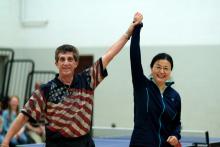Looping serves is a bit more challenging than many players imagine. However, if you follow the right thought process and use the right technique, then you will be on your way to major improvement. Here are some steps…
1. Watch the opponent’s positioning at the table and body language to possibly see if he will serve short or long.
2. Next, watch his backswing, contact point, and where the ball contacts his side of the table. At this point, you need to start adjusting your feet while keeping your hand in front.
3. Next, watch as the ball contacts your side of the table. If it hits in the first half (near the net), then it will likely be short and you need to adjust in with your legs, upper body, and racket. If it hits in the back half of the table, then it will likely be long enough to loop. These balls will vary based on spin as well.
4. Next, if the serve is half-long, then prepare to loop by keeping your knees bent, adjusting near the table with your body, and shorting your backswing while starting at the appropriate height and angle. If it is heavy backspin, then start lower and open your angle. If it is no-spin, then start higher and close your angle slightly. If the serve is fast and long, then give yourself plenty of space from the table, start at the appropriate height, let the ball come back, then spin the ball.
5. Next, focus on spinning the ball with good placement. The more spin that you are able to create when looping this serve, the easier it will be to control the ball. Without applying enough spin, your opponent’s spin with bite into your rubber and cause more errors. Generally, you should loop the half-long balls with about 30-60% power and you should loop the deep serves with about 50-80% power.
Pitfalls to avoid
1. Neglecting to watch your opponent’s racket!
2. Neglecting to move your feet based on the opponent’s racket angle and incoming ball!
3. Neglecting to adjust your racket starting position based on the opponent’s spin!
4. Neglecting to make a secondary adjustment with your feet!
5. Neglecting to apply enough spin to the ball!
Success in Looping Long Serves

Learn the step-by-step process
Category:



